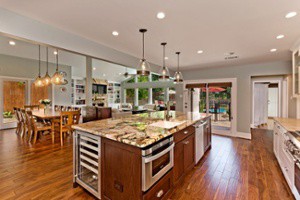Courtesy Botond Laszlo, CR, CKBR, GCP – Marvelous Home Makeovers
There is nothing like bringing the rich tones, warmth, and character of wood flooring to your home. It’s become a starting point for many of our home makeovers. Or, if not a starting point, certainly an important consideration for whatever room or rooms that make up your makeover project.
We’re seeing two main types of wood flooring: solid hardwood and engineered wood. Laminate flooring—while it has made great strides in durability and has always offered utility—doesn’t really offer long-term value.
This is the traditional type of wood flooring. It’s the type you’ll find in older homes and has clearly stood the test of time. In older homes the wood strips were narrow. Now we’re seeing more use of what’s called plank flooring, where the width of each plank is quite wide.
I like the Houzz article titled “An Introduction to Solid-Plank Wood Floors.” This article covers some of the more popular types of wood from oak to maple to bamboo. That’s just a starting point. If you do a quick web search you’ll easily find more that 100 different types of wood floors.
There are, of course, pros and cons to each type of flooring from dent resistance to its ability to hold the color of a stain to the type of grain pattern. In our homes we find that the currently popular types of wood are oak and hickory. We also find that the warmer tones are very popular. They add warmth and character to any room.
Engineered Wood
The use of engineered wood has greatly expanded over the last decade. This has been true in our makeover projects. The key is that engineered wood offers lots of options and is quite durable, including the ability to refinish the flooring.
Engineered wood is made from several layers of wood. The top layer is a veneer of the wood you’ll see on your floor. The thicker the veneer layer, the more times you’ll be able to refinish the floor over the years. There’s also a price premium for that thicker layer.
The remaining layers in the wood are plywood and can range from three to twelve layers. This construction helps the wood to hold up to moisture and increases its versatility in matching up with other flooring in terms of thickness. Houzz offers further insight in their article titled “When to Use Engineered Wood Floors.”
I will also note that engineered wood offers advantages in terms of sustainability. Because it uses much less wood in the surface layer, it limits the impact on the forests of those rare woods that look so good in our homes.
On any wood flooring we use in our projects we always seek out those that are certified by the Forest Stewardship Council or the Sustainable Forestry Initiative. This demonstrates that the wood has been harvested in a sustainable manner.
Laminate Flooring
With laminate flooring we’re in the section of What’s Not Hot. Laminate floors are a low-cost, easy maintenance option but they cannot be refinished or repaired very easily. Houzz offers some insight into this option in their article titled “Get the Look of Wood and More – for Less.”
We don’t usually recommend this option for our clients. It’s an interesting option but I feel it doesn’t offer true value over the long term.
Make It Happen
That’s a quick overview of what’s hot and what’s not in wood flooring. As you’re pulling together your dream list of options for your home makeover project, give us a call and we can provide further insight through our extensive experience with wood floors and how they can enhance your home. Visit our website or call 214.458.1932.






